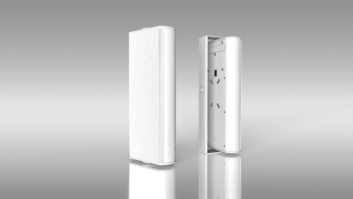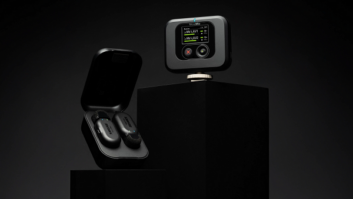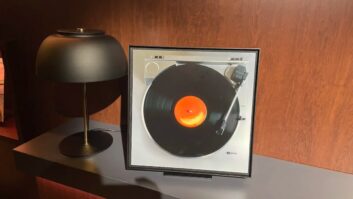Ridgefield Park, N.J. — Samsung will offer its first dedicated wireless multi-room, multisource audio system on Oct. 13 when its first Shape wireless-audio products appear in stores.
The initial lineup includes a Shape speaker that reproduces music stored on Apple and Android smartphones, stored on networked PCs, and streamed by smartphones from Cloud-based services. Music travels from the sources over a home’s Wi-Fi network to a Shape Hub, which plugs into a home’s router, distributes the music wirelessly to Shape speakers, and ensures synchronization among multiple speakers playing the same song throughout the house, the company said.
A single speaker can be used without the Hub.
The speakers also incorporate Bluetooth with nearfield communications (NFC) pairing.
The first Shape speaker is a wedge-shaped $399 AC-only active stereo speaker, which works with the $49 Hub. An optional $49 wall-mount bracket is available for the speaker. All prices fall under the company’s unilateral pricing policy.
The company plans additional compatible products, said Jim Kiczek, Samsung’s digital audio and video director, but he wouldn’t say whether the technology would be embedded in future soundbars and HTiBs as well as in more active speakers.
“This is the future of audio,” Kiczek said. “Content is all over the place, on PCs and phones, and you can control it anywhere, anytime.”
Samsung is no stranger to wireless music distribution in the house, but the company’s current wireless products consist of iPod/iPhone-docking docking speakers that incorporate Wi-Fi and Apple’s AirPlay, which offers more limited multi-room capabilities than the new Shape system and doesn’t stream music from Android phones.
Shape uses a Samsung app to turn Apple and Android smartphones into music sources that feed the Hub over a Wi-Fi 802.11a/b/g/n network with dual-band N. The app also turns the smartphones into system controllers to distribute music from networked PCs to the speakers.
An iOS and Android app for tablets is in development.
From a single smartphone, users are able to transmit multiple phone-stored songs simultaneously to 10 or more wedge-shaped speakers. The ability to stream multiple smartphone-stored songs simultaneously from a single phone is uncommon in wireless multi-room-audio systems, though Sonos and Navvo said they offer that capability.
Samsung also noted that multiple phones can be used simultaneously to stream songs to different speakers.
Besides reproducing music stored on mobile devices and PCs, the speakers also reproduce Cloud-based music services incorporated in Samsung’s app. The services include TuneIn Internet radio, Pandora, Rhapsody and the Amazon Cloud Player.
A single smartphone can transmit a music service to one set of speakers and a stored song to another set of speakers.
The mobile devices also access DLNA-equipped computers and laptops to direct PC-stored music to the speakers. PCs lacking DLNA must be loaded with the Samsung app to connect to the speakers. Multiple songs can be streamed simultaneously from a single PC to different speakers.
The system also supports simultaneous streaming from a PC and from smartphones.
The speaker also stream audio from Bluetooth-equipped Samsung TVs, including audio from smart-TV apps, such as music-streaming services.
The glue that holds the system together is the $49 Hub, which ensures synchronization among multiple speakers playing the same song throughout the house, the company said.
The speakers themselves can be placed horizontally or vertically via an included stand. When two speakers are placed vertically in the same room, they automatically turn into separate left-right speakers to improve stereo separation.
The system is easy to install and use and delivers high-performance audio, said Kiczek. To install the system, users plug the Hub into a router and then turn on the Hub and speakers, which automatically connect via wireless to the Hub.
The Android and iOS app is intuitive to use, enabling users to drag songs to different rooms for playback, Kiczek said. Multiple rooms can be grouped into different groups for playback.
The volume of each speaker can be controlled from the phone’s touchscreen or from the phone’s own volume button. The speakers are always in standby mode, ready to reproduce music when an audio signal comes in.
The optional wall bracket can be used to tilt the speaker in any direction or mount the speaker directly in a corner.
To support the launch, Samsung plans print and online advertising, a social-media program, and in-store demonstrators that let shoppers press a button to activate a speaker, Kiczek said.













